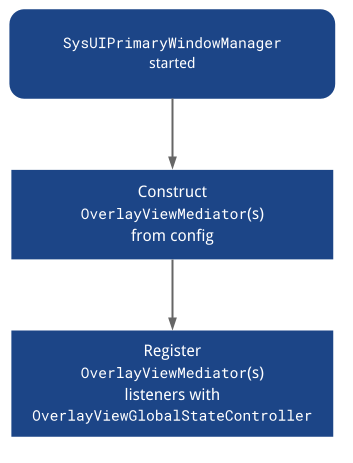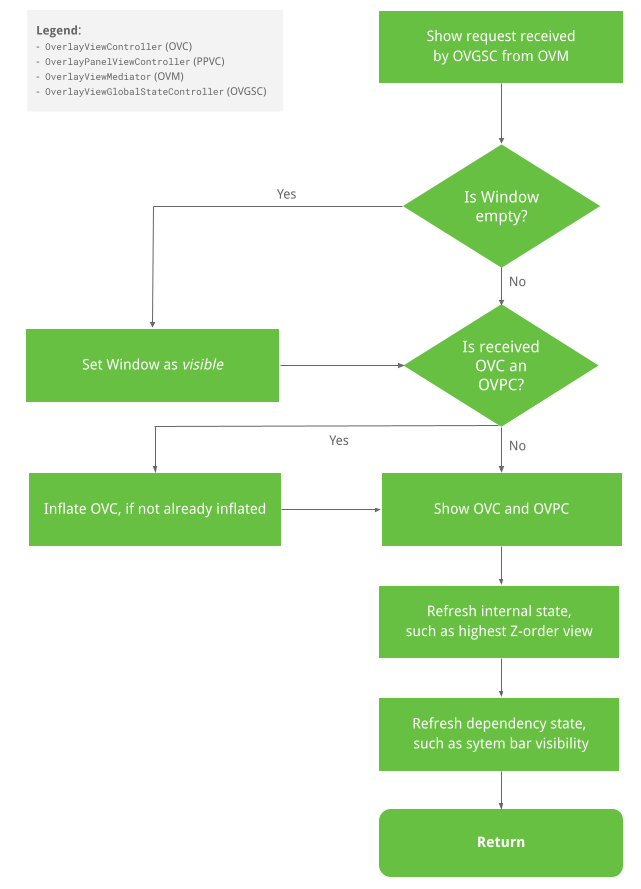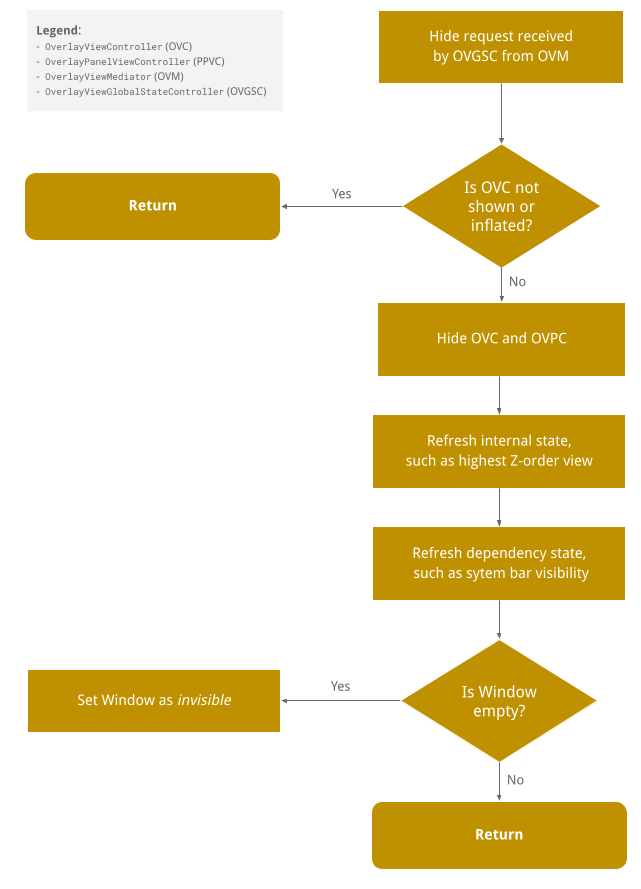Sistem pengelolaan SystemUIOverlayWindow menyediakan cara bagi Anda untuk menampilkan dan
mengelola tampilan di SystemUIOverlayWindow. Saat ini, jendela ini digunakan untuk tampilan
termasuk pengalih pengguna layar penuh, panel notifikasi, dan pelindung kunci. Halaman ini tidak:
- Buat batasan terkait hal yang dapat ditambahkan OEM ke jendela.
- Memaksa Anda untuk mengadopsi abstraksi yang dijelaskan di halaman ini.
Ringkasan
Anda dapat menggunakan Sistem Pengelolaan SystemUIOverlayWindow untuk menampilkan tampilan seperti
pemberitahuan hukum, pengalih pengguna layar penuh, kamera belakang, kontrol HVAC, dan pelindung kunci. Jendela
ini berada di luar ruang aplikasi dan memberi Anda kontrol atas urutan Z tampilan,
pemicu tampilan/sembunyikan, dan penyesuaian secara keseluruhan, termasuk penempatan tampilan, ukuran, transparansi,
dan warna. Pada saat yang sama, Anda tidak perlu khawatir dengan status panel sistem atau
objek UI Sistem lainnya yang perlu disembunyikan atau ditampilkan saat tampilannya disembunyikan atau ditampilkan.
Untuk memanfaatkan SystemUIOverlayWindow, Anda membuat pengontrol tampilan untuk mediator
tampilan. Mediator diteruskan ke pengontrol status global jendela. Mediator tampilan ini:
- Koordinasi antar-pengontrol tampilan.
- Menampung logika bisnis untuk pengontrol tampilan.
Pengontrol tampilan (dikoordinasikan oleh mediator tampilan):
- Miliki tampilannya.
- Buat penyetel yang dapat digunakan
OverlayViewsMediatoruntuk melampirkan logika bisnis. - Buat animasi tampilan yang ditampilkan dan disembunyikan.
SystemUIOverlayWindowManager, komponen SystemUI, berfungsi sebagai titik entri untuk
melakukan inisialisasi dan mendaftarkan mediator dengan pengontrol status global, sedangkan pengontrol status global
terhubung ke pengontrol tampilan sedemikian rupa sehingga mediator dapat langsung memanggil pengontrol tampilan
untuk menampilkan dan menyembunyikan tampilan di jendela.
OverlayViewController
OverlayViewController
bertanggung jawab atas tampilan yang ditampilkan di SystemUIOverlayWindow dan mengontrol cara tampilan
ditampilkan dan disembunyikan. Hal ini juga memungkinkan pemroses yang diperlukan untuk dilampirkan sehingga dapat dikaitkan
dengan logika bisnis.
Tanda tangan metode penting
/**
* Owns a {@link View} that is present in SystemUIOverlayWindow.
*/
public class OverlayViewController {
/**
* Shows content of {@link OverlayViewController}.
*
* Should be used to show view externally and in particular by {@link OverlayViewMediator}.
*/
public final void start();
/**
* Hides content of {@link OverlayViewController}.
*
* Should be used to hide view externally and in particular by {@link OverlayViewMediator}.
*/
public final void stop();
/**
* Inflate layout owned by controller.
*/
public final void inflate(ViewGroup baseLayout);
/**
* Called once inflate finishes.
*/
protected void onFinishInflate();
/**
* Returns {@code true} if layout owned by controller has been inflated.
*/
public final boolean isInflated();
/**
* Subclasses should override this method to implement reveal animations and implement logic
* specific to when the layout owned by the controller is shown.
*
* Should only be overridden by Superclass but not called by any {@link OverlayViewMediator}.
*/
protected void showInternal();
/**
* Subclasses should override this method to implement conceal animations and implement logic
* specific to when the layout owned by the controller is hidden.
*
* Should only be overridden by Superclass but not called by any {@link OverlayViewMediator}.
*/
protected void hideInternal();
/**
* Provides access to layout owned by controller.
*/
protected final View getLayout();
/** Returns the {@link OverlayViewGlobalStateController}. */
protected final OverlayViewGlobalStateController getOverlayViewGlobalStateController();
/** Returns whether the view controlled by this controller is visible. */
public final boolean isVisible();
/**
* Returns the ID of the focus area that should receive focus when this view is the
* topmost view or {@link View#NO_ID} if there is no focus area.
*/
@IdRes
protected int getFocusAreaViewId();
/** Returns whether the view controlled by this controller has rotary focus. */
protected final boolean hasRotaryFocus();
/**
* Sets whether this view allows rotary focus. This should be set to {@code true} for the
* topmost layer in the overlay window and {@code false} for the others.
*/
public void setAllowRotaryFocus(boolean allowRotaryFocus);
/**
* Refreshes the rotary focus in this view if we are in rotary mode. If the view already has
* rotary focus, it leaves the focus alone. Returns {@code true} if a new view was focused.
*/
public boolean refreshRotaryFocusIfNeeded();
/**
* Returns {@code true} if heads up notifications should be displayed over this view.
*/
protected boolean shouldShowHUN();
/**
* Returns {@code true} if navigation bar insets should be displayed over this view. Has no
* effect if {@link #shouldFocusWindow} returns {@code false}.
*/
protected boolean shouldShowNavigationBarInsets();
/**
* Returns {@code true} if status bar insets should be displayed over this view. Has no
* effect if {@link #shouldFocusWindow} returns {@code false}.
*/
protected boolean shouldShowStatusBarInsets();
/**
* Returns {@code true} if this view should be hidden during the occluded state.
*/
protected boolean shouldShowWhenOccluded();
/**
* Returns {@code true} if the window should be focued when this view is visible. Note that
* returning {@code false} here means that {@link #shouldShowStatusBarInsets} and
* {@link #shouldShowNavigationBarInsets} will have no effect.
*/
protected boolean shouldFocusWindow();
/**
* Returns {@code true} if the window should use stable insets. Using stable insets means that
* even when system bars are temporarily not visible, inset from the system bars will still be
* applied.
*
* NOTE: When system bars are hidden in transient mode, insets from them will not be applied
* even when the system bars become visible. Setting the return value to {@true} here can
* prevent the OverlayView from overlapping with the system bars when that happens.
*/
protected boolean shouldUseStableInsets();
/**
* Returns the insets types to fit to the sysui overlay window when this
* {@link OverlayViewController} is in the foreground.
*/
@WindowInsets.Type.InsetsType
protected int getInsetTypesToFit();
/**
* Optionally returns the sides of enabled system bar insets to fit to the sysui overlay window
* when this {@link OverlayViewController} is in the foreground.
*
* For example, if the bottom and left system bars are enabled and this method returns
* WindowInsets.Side.LEFT, then the inset from the bottom system bar will be ignored.
*
* NOTE: By default, this method returns {@link #INVALID_INSET_SIDE}, so insets to fit are
* defined by {@link #getInsetTypesToFit()}, and not by this method, unless it is overridden
* by subclasses.
*
* NOTE: {@link #NO_INSET_SIDE} signifies no insets from any system bars will be honored. Each
* {@link OverlayViewController} can first take this value and add sides of the system bar
* insets to honor to it.
*
* NOTE: If getInsetSidesToFit is overridden to return {@link WindowInsets.Side}, it always
* takes precedence over {@link #getInsetTypesToFit()}. That is, the return value of {@link
* #getInsetTypesToFit()} will be ignored.
*/
@WindowInsets.Side.InsetsSide
protected int getInsetSidesToFit();
}OverlayPanelViewController
Pengontrol OverlayPanelViewController memperluas OverlayViewController dan memberikan kemampuan animasi menarik tambahan ke superclass-nya.
OverlayViewMediator
OverlayViewMediator menyimpan logika bisnis yang menampilkan atau menyembunyikan
beberapa instance OverlayViewController, sehingga, dengan cara tertentu, OverlayViewMediator juga mengelola
koordinasi antara pengontrol tampilan.
/** * Controls when to show and hide {@link OverlayViewController}(s). */ public interface OverlayViewMediator { /** * Register listeners that could use ContentVisibilityAdjuster to show/hide content. * * Note that we do not unregister listeners because SystemUI components are expected to live * for the lifecycle of the device. */ void registerListeners(); /** * Allows for post-inflation callbacks and listeners to be set inside required {@link * OverlayViewController}(s). */ void setupOverlayContentViewControllers(); }
SystemUIOverlayWindowManager
SystemUIOverlayWindowManager
bertanggung jawab untuk menjadi objek SystemUI yang berfungsi sebagai titik entri bagi
Sistem Pengelolaan SystemUIOverlayWindow untuk melakukan inisialisasi dan mendaftarkan
instance OverlayViewMediator dengan OverlayViewGlobalStateController.

OverlayViewGlobalStateController
OverlayViewGlobalStateController menerima panggilan dari
instance OverlayViewController untuk mengungkapkan atau menyembunyikan dirinya. Oleh karena itu, class ini juga
menyimpan status apa yang ditampilkan atau disembunyikan di SystemUIOverlayWindow.
Alur tampilan acara diilustrasikan di bawah ini:

Menyembunyikan alur tampilan
Alur tampilan tersembunyi diilustrasikan di bawah:

Tanda tangan metode publik
Tanda tangan metode publik dienkode sebagai berikut:
/**
* This controller is responsible for the following:
* <p><ul>
* <li>Holds the global state for SystemUIOverlayWindow.
* <li>Allows {@link SystemUIOverlayWindowManager} to register {@link OverlayViewMediator}(s).
* <li>Enables {@link OverlayViewController)(s) to reveal/conceal themselves while respecting the
* global state of SystemUIOverlayWindow.
* </ul>
*/
@SysUISingleton
public class OverlayViewGlobalStateController {
/**
* Register {@link OverlayViewMediator} to use in SystemUIOverlayWindow.
*/
public void registerMediator(OverlayViewMediator overlayViewMediator);
/**
* Show content in Overlay Window using {@link OverlayPanelViewController}.
*
* This calls {@link OverlayViewGlobalStateController#showView(OverlayViewController, Runnable)}
* where the runnable is nullified since the actual showing of the panel is handled by the
* controller itself.
*/
public void showView(OverlayPanelViewController panelViewController);
/**
* Show content in Overlay Window using {@link OverlayViewController}.
*/
public void showView(OverlayViewController viewController, @Nullable Runnable show);
/**
* Hide content in Overlay Window using {@link OverlayPanelViewController}.
*
* This calls {@link OverlayViewGlobalStateController#hideView(OverlayViewController, Runnable)}
* where the runnable is nullified since the actual hiding of the panel is handled by the
* controller itself.
*/
public void hideView(OverlayPanelViewController panelViewController);
/**
* Hide content in Overlay Window using {@link OverlayViewController}.
*/
public void hideView(OverlayViewController viewController, @Nullable Runnable hide);
/** Returns {@code true} is the window is visible. */
public boolean isWindowVisible();
/**
* Sets the {@link android.view.WindowManager.LayoutParams#FLAG_ALT_FOCUSABLE_IM} flag of the
* sysui overlay window.
*/
public void setWindowNeedsInput(boolean needsInput);
/** Returns {@code true} if the window is focusable. */
public boolean isWindowFocusable();
/** Sets the focusable flag of the sysui overlawy window. */
public void setWindowFocusable(boolean focusable);
/** Inflates the view controlled by the given view controller. */
public void inflateView(OverlayViewController viewController);
/**
* Return {@code true} if OverlayWindow is in a state where HUNs should be displayed above it.
*/
public boolean shouldShowHUN();
/**
* Set the OverlayViewWindow to be in occluded or unoccluded state. When OverlayViewWindow is
* occluded, all views mounted to it that are not configured to be shown during occlusion will
* be hidden.
*/
public void setOccluded(boolean occluded);
}Cara menambahkan tampilan ke SysUIOverlayWindow
Untuk mengetahui detailnya, lihat Codelab.
Langkah 1: Tambahkan ViewStub ke SysUIOverlayWindow
Tambahkan ViewStub
ke
tata letak jendela.
Langkah 2: Buat OverlayViewController
Gunakan ViewStub baru untuk membuat OverlayViewController
yang dapat diinjeksi baru.
Langkah 3: OverlayViewMediator
Buat OverlayViewMediator
yang dapat diinjeksi
baru atau gunakan yang sudah ada (lewati Langkah 4) dan daftarkan pemroses untuk menyembunyikan atau menampilkan
OverlayViewController baru.
Langkah 4: Konfigurasikan OverlayViewMediator baru
Tambahkan OverlayViewMediator baru ke
OverlayWindowModule
dan ke
config_carSystemUIOverlayViewsMediator.
Peringatan
Saat SysUIPrimaryWindow menutupi seluruh layar, elemen apa pun di bawah jendela
tidak akan mendaftarkan peristiwa sentuh. Oleh karena itu, saat jendela menutupi seluruh layar, tetapi kontennya
meninggalkan beberapa ruang negatif, Anda dapat memilih untuk memburamkan ruang negatif dan melampirkan pemroses ke
ruang tersebut untuk menutup konten di jendela.

